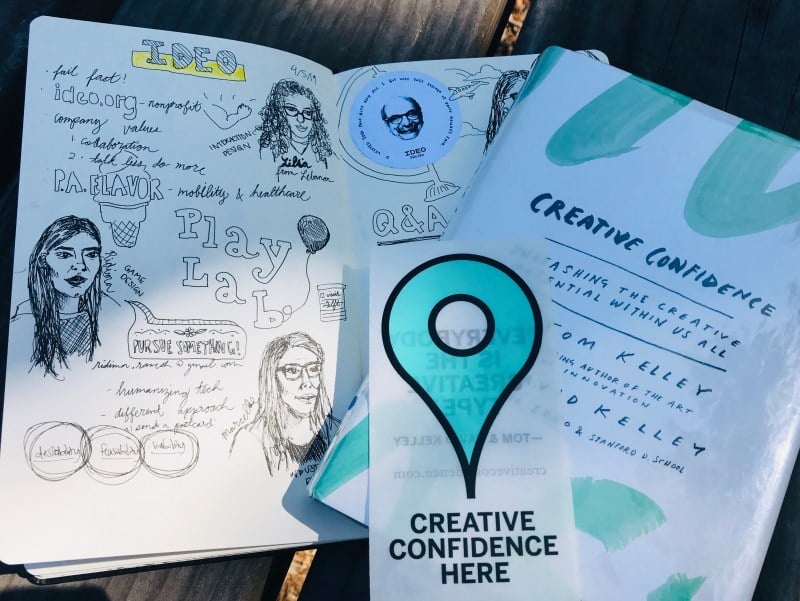There was no mistaking the thick, black-rimmed glasses and the walrus-like mustache. It was David Kelley himself, founder of design firm IDEO and the Stanford d.school. As my Uber drove back to campus, I stared into the sticker in the palm of my hand that signified I was a visitor, emblazoned with “I visited IDEO Palo Alto and all I got was this sticker of David Kelley’s face.” Although I left with a dazzling impression of IDEO, I still had more than a few questions about design thinking.
Walking through IDEO felt like an ad for neon Post-Its, which were littered across every surface. The pseudo-fireplace, Play Lab and vintage-car-turned-makerspace added to the whimsicality of the place. After my brief visit, I felt like I had been post-football-game Gatorade-showered, except with creativity instead of Gatorade. It was like meeting the d.school’s attractive older sibling.
I arrived back at campus intrigued, but still mildly skeptical of design thinking, the human-centered design methodology that Kelley advocates. “Dinking,” as some prefer to call it, has quickly become embedded into Stanford’s culture. Clubs and classes preach the five steps — empathize, define, ideate, prototype and test — but what do they look like in real life? To find out, I read “Creative Confidence: Unleashing the Creative Potential Within Us All,” co-authored by David Kelley and his brother Tom Kelley, a partner at IDEO and fellow innovator.
I was immediately drawn in by the handwritten cover and playful watercolor illustrations. Anecdotes of success stories from the Kelley brothers’ decades of experience interacting with industry leaders and students at Stanford are supplemented with brief practical exercises that can be done individually or company-wide. A wide variety of industries are represented in the stories, from healthcare to tech and everything in between. The stories are heavily centered around IDEO and the d.school, making “Creative Confidence” read like a brochure, albeit an entertaining one, at times.
The Kelley brothers’ passionate proselytizing is rife with lines like “If you want a good idea, start with a lot of ideas” and “Creative confidence is like a muscle.” People often have the misconception that creatives are in a separate category from everybody else. However, these quotes reveal that persistence will often get you farther than raw talent. Although these may not be novel discoveries, I believe it’s still important and helpful to reinforce these ideas that we often forget or find easy to ignore.
Another aspect of the book that I appreciated was its human-centric focus. Many of the featured projects generated positive social impact (in addition to being extremely cool). Doug Dietz, a designer of MRI machines, employed design thinking when he found out children were often so scared of the machine that they had to be sedated. He created a pirate ship-themed MRI machine that transformed the process of scanning from a frightening experience into an adventure. As a prospective designer, it got me excited about the possibilities of the needs I could fulfill, and about why design is meaningful as a whole.
The title “Unleashing the Creative Potential Within Us All” really gets at the core of the book. Essentially, the Kelley brothers not only believe that creativity can be harnessed by anybody, but also that it can enrich the careers of people even in traditionally “noncreative” industries. And often it is confidence, rather than skill or expertise, that propels creative endeavors.
Although my visitor sticker said that “All I got was this sticker of David Kelley’s face,” that actually wasn’t true. I also left with a bold turquoise sticker that reads, “CREATIVE CONFIDENCE HERE.” I keep in on my sketchbook as a reminder to be confident in my creative ventures. Because reading a book, no matter how energizing, will only get you so far. And the great thing about creativity is that there’s never a point at which you’ve maxed out your full potential. So go out and dink!
Contact Sarah Kim at skim22 ‘at’ stanford.edu.
